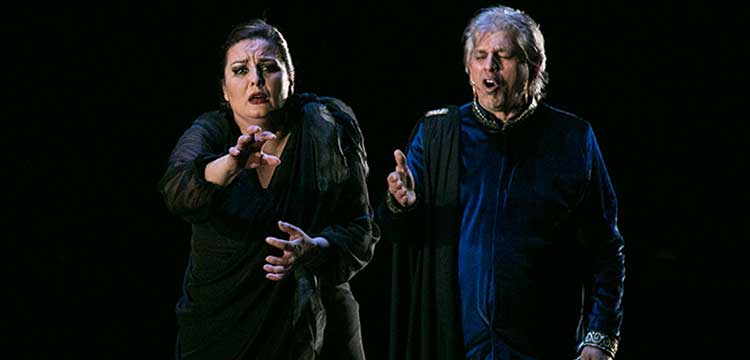23rd FESTIVAL DE JEREZ
Compañía María del Mar Moreno “Medea de Pilar Távora”
Friday, March 8th, 2019. 9:00pm. Teatro Villamarta
Especial Festival de Jerez
(photos / video / spanish show review)
Estela Zatania
Script-writer and director: Pilar Távora. Flamenco choreography: María del Mar Moreno. Jason: Jesús Herrera. Singer-Corifeo: Antonio Malena. Music composition and guitar: Santiago Moreno. Andalusí singer: Imán Kandoussi. Choral singers: Zaira Malena, Ana Real. Guitar: Malena hijo. Percussion: Alé de Gitanería. Rhythm: Javi Peña, Manuel Cantarote. Actresses-chorus: Cristina Almazán, Pilar Herranz, Beatriz Ortega. Corps de ballet-chorus: Irene Olivares, Salomé Humeau, Cristina Vidal. Verses, song organization and final text: Pilar Távora.
International Women’s Day, and the streets of many countries throughout the world are full of various activities and protests. I had to push through a demonstration on the Calle Larga in Jerez to get to the Villamarta theater.
Two hours earlier, at the Villavicencio Palace, young singer Juan de Mairena, gave a well-rounded recital with a well-prepared classic repertoire, interpreted with the clear intention of giving the best with his high register voice, singing at 5 or 6 in “A” position for the basic forms. There were good vibrations with Diego del Morao on guitar, indulging in his most typically Jerez sound in the accompaniment of soleá, taranta, alegrías, tientos tangos, siguiriyas y bulería romance with fandango encore.
Shortly afterwards, at the Villamarta theater, the popular Jerez dancer María del Mar Moreno presented “Medea de Pilar Távora”, an ambitious project made with intelligence and affection. The classic work of Euripides has undergone many versions, including the unforgettable interpretation of Manuela Vargas with the Ballet Nacional, with the music of Manolo Sanlúcar, which debuted in 1984.
It’s a convoluted story of abandonment, treachery and death that fits in with the feminist agenda and lends itself to diverse interpretations, on this occasion an updated reading that gives a certain dignity to the central character of Medea. She is identified in María del Mar and shows that a certain flamenco sensibility resides in this classic Greek tragedy, in a culture that existed centuries before the first pre-flamenco singing of Tío Luis el de la Juliana, so this is a universally human work.
It seems whenever a director or scriptwriter gets ahold of flamenco, a struggle ensues between good theater and good music/dance, with the former often coming out on top. In this case, with the directing of Pilar Távora, both teams showed their best and bravest faces. In dance, María del Mar and her Jason played by the terrific dancer Jesús Herrera gave us wonderful moments of extreme beauty and power, along with the singing of Antonio Malena and the guitars of his son and of Santiago Moreno. The voice of the traditional Arabic singer, Imán Kandoussi, was a stroke of genius that situated us in that culturally rich and diverse environment.
At some moments it seemed the theater element had won the “match” with long dialogues or conversations, and several filmed segments that left our ears and eyes wanting to hear and see more music and dance. However, despite a few rough spots, you could declare a tie thanks to the final siguiriya sung convincingly by María del Mar, better than a lot of people could manage.
